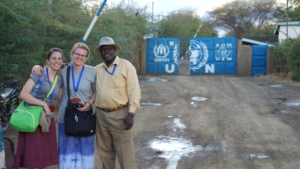To get a better understanding of what our refugee friends’ lives look like in the refugee camp, in November 2015, two Arrive Ministries staff members spent two weeks in Kakuma Refugee Camp in Northwest Kenya. Michelle Eberhard, the Director of Arrival Services writes about the contradictory ways of life in Kakuma Refugee Camp; refugees living in what should be a temporary home, but are left unable to plan for the future.
Empty Bellies

Three Empty Red Cups
Three little red cups. Two stacked on top of each other, and a third lying on its side, remnants of the morning’s porridge – a thick, sweet liquid akin to mixing maple syrup with apple cider – sticking to their sides. For some reason, I was mesmerized by these cups, trying to reconcile the brilliance of their plastic exterior with the dull, stark environment around me. Perhaps my captivation could be attributed to the fact that the cups were lying in the dust, discarded, and unlikely to be fully washed before the next day’s use. Perhaps it was my rejection of the notion that this substance could provide any type of sustaining nutrition to anyone. After all, I myself had sipped some porridge in the NGO compound the previous day, and I had never considered that it would replace the dinner served to me hours later.

The author, Michelle Eberhard (L) and Jessica Wills (R)
In all reality, however, I knew the reason I was transfixed by the cups was because I had just heard the schoolteacher explain a few minutes before that the porridge is served daily at 6am. 6am is an hour and a half before the school day begins. It is seven hours before a lunch break that several hundred of the 2,611 girls who attend his school won’t go home for, because there will be nothing there for them to eat. It is ten hours until classes will be dismissed for the day. The contents of the cups I stared at were all there would be until the girl who smiled at me from the classroom window would return to her plot of earth – and then, dinner’s availability would simply depend on whether her mother had a menial job in the camp, or whether her family’s monthly ration could be stretched any further. The only thing emptier than the cups I couldn’t look away from, it seemed, was the bellies they could never hope to fill.
Contradictory Realities; Temporary Homes

Girl Waving from Window, in Kakuma Refugee Camp
This is the way of Kakuma. To walk its dirt paths is to perpetually juxtapose two contradictory thoughts that are at the same time both completely, one hundred percent true. Refugee camps are intended to be an “exception,” a “temporary measure” in response to prolonged crisis. Nobody wants more for this to be true than the refugee himself. But in Kakuma, I met a man who has called this uninhabitable desert home for 23 years – as long as the camp has been in existence. I met a Rwandan woman in her twenties who has never once been to Rwanda. So tell me, how long can something truly be temporary?

Main Street of Kakuma Refugee Camp
Much of my visit to Kakuma was spent listening to the not-so-temporary realities of camp life from the refugees themselves, and trying to understand what it means to exist there. The people I met shared with me the struggles they endure, such as walking miles to the nearest water tap only to find it turned off that day for maintenance, or sleeping with one eye open for fear of the night and the knowledge that no justice is possible unless a substantial bribe to the local policeman can be made. As I listened, I also heard what wasn’t being said – that the beautiful human beings I quickly began to know as friends were irreversibly stuck between a life in motion and a life that just wouldn’t move forward.

Kakuma Refugee Camp, Sometimes described as an “Open Prison”
And yet, despite everything, many of them did find a way to move, like the young Sudanese man I met in a garden run by the NGO that hosted us, who sold enough vegetables over multiple years to purchase a computer and enroll in online classes through Coursera. “We will never give up,” he told me. Or like the pastors who escorted us throughout the camp each day, faithfully guiding us as they do their own neighbors, and always, always holding fast to their mission “to reach the world from Kakuma,” in the unwavering belief that God has “big plans” for this place. Such incongruence – hope in a desperate place, love in a space created out of the necessity to combat hatred – was so difficult to comprehend.
Living in Tension

Man Transporting Sticks on his Bicycle
And so, when I am asked what it was like in Kakuma, I talk about the way two opposite things could ever impossibly exist together: deprivation and abundance, loss and beauty, pain and strength, anger and love. The dichotomy is the truth, and it was clear that the person who could navigate both sides – “by the grace of God,” as everyone told me, and as I too believe – was the person who could survive there.
Cups, like hearts, are meant to be filled. Cups, like humans, must be given the contents to nourish and sustain a life of dignity. Just because a person can endure the injustice of Kakuma doesn’t mean it should ever be acceptable that he does. To survive and not live is a tragic, empty fate. That’s why for me, three little red cups in the doorway of a derelict primary school in northwest Kenya will forever symbolize both the impossible suffering and the miraculous hope of a people who shouldn’t have to, but somehow do, find ways to move in temporary permanence.
Read another account of life in Kakuma written by Refugee Life Ministries Program Director, Jessica Wills.
This trip was made in partnership with the International Association for Refugees (IAFR), and some of the pictures above are from Tom Albinson, the president of IAFR, who made the trip possible.





